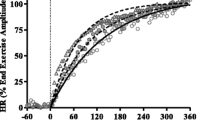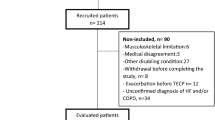Abstract.
To be clinically useful as indices reflective of altered physiological function consequent to interventions in patients with chronic obstructive pulmonary disease (COPD), the time constant (τ) and steady-state amplitude of the kinetic responses for oxygen uptake (\( \dot V{\rm O}_{\rm 2} \) ) carbon dioxide output (\( \dot V{\rm CO}_{\rm 2} \) ) ventilation (\(\dot V_{\rm E} \) ) and heart rate (HR) have to be appropriately differentiable and reproducible. We therefore assessed the reproducibility of τ and steady state amplitude values in 41 patients with severe COPD [mean (SD)] [forced expiratory volume in 1 s=41 (7)% predicted], aged 64 (5) years. Of the total, 6 of the patients (15%) did not produce breath-by-breath data of sufficient quality to warrant kinetic analysis. The remaining 35 patients completed two moderate-intensity 10 min square-wave exercise tests separated by 2 h, both before and after an endurance training programme. Tests were conducted on an electromagnetically-braked cycle ergometer at an exercise intensity corresponding to 80% of the estimated lactate threshold (θLa) or 50% of peak oxygen uptake if θLa was insufficiently differentiable. Breath-by-breath measurements of \( \dot V{\rm O}_{\rm 2} \) , \( \dot V{\rm CO}_{\rm 2} \) , \(\dot V_{\rm E} \) and HR were averaged into 10 s bins and the on-transient response kinetics were estimated using a mono-exponential model. Analysing the pre-training and the post-training test 1 and test 2 comparisons together, the test 1 –test 2 differences were not significantly different from 0 for either τ or A. The standard deviation of the test 1 –test 2 differences allowed us to define the magnitude of change that would reach statistical significance. For τ, this averaged some 8, 10, 11 and 8 s, for \( \dot V{\rm O}_{\rm 2} \) , \( \dot V{\rm CO}_{\rm 2} \) , \(\dot V_{\rm E} \) and HR, respectively, for a one-tailed paired-comparisons test (i.e. appropriate for assessing hypothesised improvements resulting from an intervention); for a two-tailed comparison, the differences were approximately 2 s greater. The corresponding one-tailed values for A were 100 ml·min–1, 95 ml·min–1, 2.5 1·min–1 and 4 beats·min–1, respectively; the two-tailed values were 10%–15% greater. We therefore conclude that both τ and A for moderate-intensity exercise can be reproducibly estimated in patients with COPD when the data set provides a sufficiently large amplitude of response and sufficiently low sample variability to allow appropriate parameter estimation.
Similar content being viewed by others
Author information
Authors and Affiliations
Additional information
Electronic Publication
Rights and permissions
About this article
Cite this article
Puente-Maestu, L., Sánz, .M., Sánz, P. et al. Reproducibility of the parameters of the on-transient cardiopulmonary responses during moderate exercise in patients with chronic obstructive pulmonary disease. Eur J Appl Physiol 85, 434–441 (2001). https://doi.org/10.1007/s004210100486
Accepted:
Issue Date:
DOI: https://doi.org/10.1007/s004210100486




